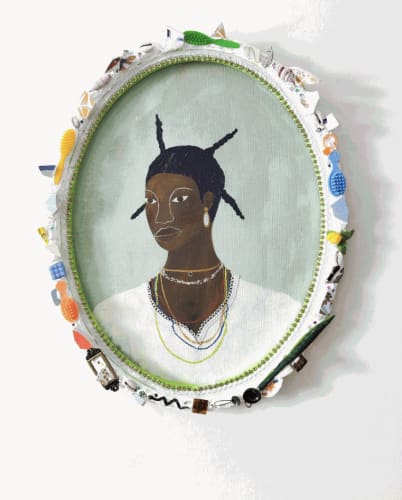How are Brazilian artists with African heritage using a new visual vocabulary to make space for a more fecund relationship with the continent?
In 2022, Rio de Janeiro’s Museum of Art put out a call for works on and about important Black figures in Brazil for an iteration of the exhibition Enciclopédia Negra (Black Encyclopaedia). The São Paulo-based artist Larissa De Souza responded. Among other works, she submitted Nã Agontime (2022), an acrylic and mica pearl portrait of a handsome Black woman in a white blouse. The figure’s hairstyle is decidedly African, with long threaded spikes. Lavish jewellery adorns her neck and ears. She radiates a quiet dignity while her fervent eyes and tribal marks suggest a deep well of strength. The oval resin frame is studded with rocks, broken tiles, seashells, plastic combs and other ephemera that De Souza has referred to in interviews as amulets. The retratos pintados (painted portraits) style of northeast Brazil, in which plain black-and-white family portraits were beautified with colour, fancy clothing and jewellery, was a nod to the artist’s family roots in the area. The choice of the figure, Na Agontimé, is a nod to her African ancestry. Na Agontimé, an eighteenth-century wife of King Agonglo of Dahomey, was sold into slavery in Brazil. In São Luis, on the north coast of the country, where she is believed to have settled, she is credited with the founding the Casa das Minas temple, home of the Afrobrazilian religious practice of Tambor de Mina.

